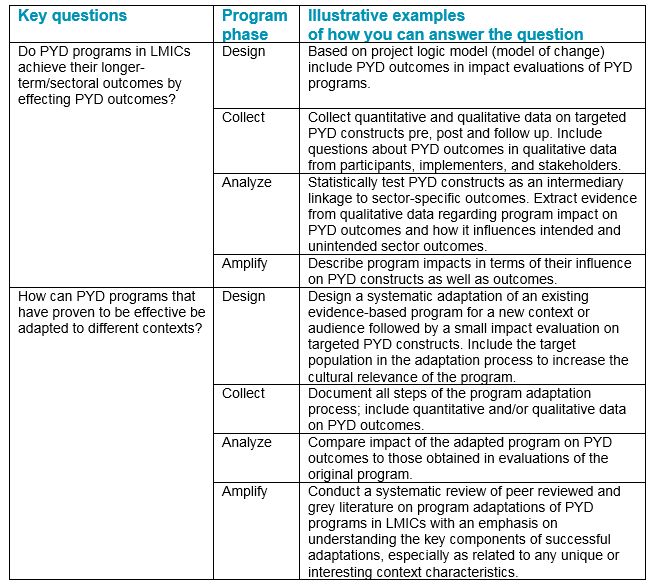Understanding How PYD Programs Achieve Positive Impact in LMICs
GAP: Most of the programs identified in the systematic review did not self-identify as PYD, nor did they consistently measure PYD outcomes (e.g., self-regulation, positive identity, self-efficacy).
Although PYD programs have been implemented and tested in low- and middle-income countries (LMICs), and some of them have demonstrated positive effects on health, employment, and/or wellbeing, few studies included measures or evaluations of how these effects were achieved. For example, a program may be designed to improve youth employment outcomes and include vocational and life skills training, mentoring, and a community service component. Through various activities, the program applies PYD features such as building skills, healthy relationships, and bonding, and fostering youth contribution in order to add to the desired outcome of employment. When a rigorous evaluation demonstrates improved employment outcomes, it is also important to determine if the program achieved PYD outcomes by improving skills, relationships, and youth contribution as intended. This kind of research would provide strong evidence PYD leads to positive sector outcomes downstream.
The effects of PYD on longer-term/sectoral outcomes are also important to analyze within various contexts. This analysis is especially important in LMICs, where activities need to be tailored to the local situation. Ongoing conflict, instability, and other local conditions can make it impossible to replicate the activities of a program that was successful elsewhere. Research on how successful programs achieve their goals can help program developers understand the complex set of PYD features that have been demonstrated to be effective in similar environments (e.g., conflict vs. non-conflict areas). Youth also live at the intersections of various marginalized identities, which may include their race, gender identity and expression, age, sexual orientation, immigration status, ability, and more. Programs must consider the complexities within youth lives in order to effectively impact youth outcomes.
Key questions and illustrative sub-questions
1. Do PYD programs in LMICs achieve their longer-term/sectoral outcomes by effecting PYD outcomes?
- Do PYD programs impact their intended PYD outcomes?
- Are changes in PYD outcomes linked to improved longer-term, sectoral outcomes for program beneficiaries?
2. How can PYD programs that have proven to be effective be adapted to different contexts?
- Are there examples of successful adaptations of evidence-based PYD programs in LMICs?
- Are there systematic ways of adapting evidence-based PYD programs to different contexts, situations, or audiences in LMICs?
- What are the most cost-effective ways to adapt PYD programs to specific conditions in LMICs?
Click the button below to access recent learnings on Understanding How PYD Programs Achieve Positive Impact in LMICs.
Potential Strategies to Address Understanding How PYD Programs Achieve Positive Impact in LMICs:








